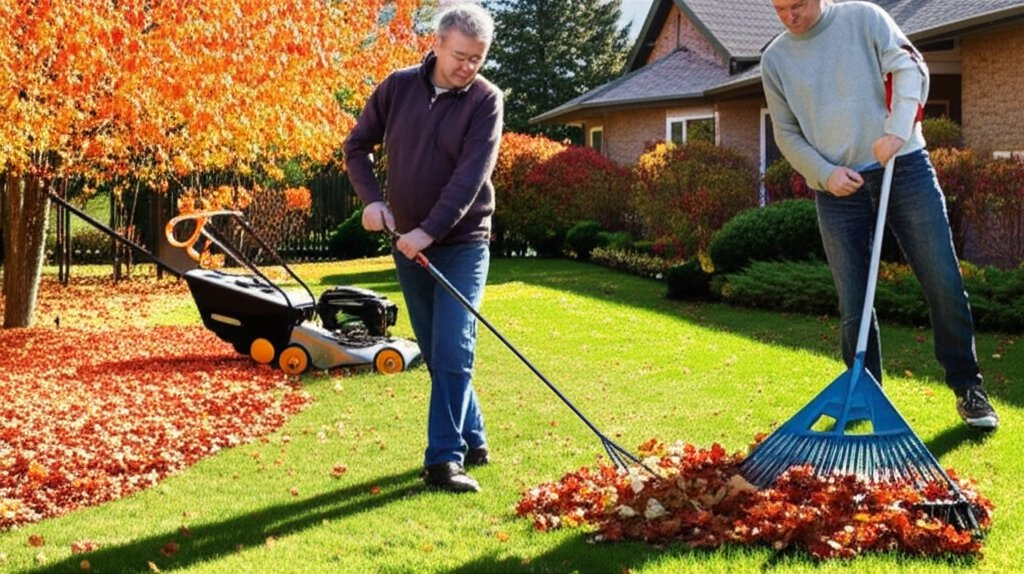Fall Yard Work Saves You From Expensive Spring Repairs
As winter approaches, your yard faces challenges from cold, wet weather. Freezing water expands tiny cracks into larger damage, while fallen leaves trap moisture that stains surfaces and fosters disease. Investing a little time in fall maintenance protects your lawn, beds, and hardscapes, ultimately saving you from costly spring repairs. This guide outlines essential tasks to tackle now for a healthier, more resilient yard.
Priority Tasks to Protect Your Property
- Clear Leaves and Debris: Remove leaves from lawns, garden beds, and drainage areas weekly until the last drop. Wet leaf piles lead to snow mold on grass, patio staining, and clogged drains; mulch them into small pieces with a mower or bag them for disposal.
- Clean Gutters and Downspouts: Ensure water flows freely by clearing debris from gutters, preventing overflow that damages siding or forms ice dams. Install extensions to direct water at least 10 feet from your foundation.
- Strengthen Lawn Health: Aerate compacted soil to improve root access to air and water, then overseed at a rate of 3 to 6 pounds per 1,000 square feet. Follow with a balanced fall fertilizer to fortify roots against freeze-thaw cycles.
- Prepare Beds and Shrubs: Trim back dead perennials and remove diseased plant material to reduce pest risks, then apply 2 to 3 inches of mulch, keeping it several inches from tree trunks to avoid rot.
- Maintain Hardscapes and Drainage: Sweep dirt from paver joints and refill with polymeric sand to prevent erosion and weed growth. Seal porous concrete or stone surfaces and ensure a slope of 1 inch per foot away from your home for proper runoff.
- Prune Trees Safely: Cut away dead or overlapping branches, especially those near roofs or power lines, hiring a certified arborist for high or hazardous limbs to avoid property damage.
- Winterize Irrigation Systems: Turn off water supply to sprinklers, use compressed air to clear lines, and drain hoses to prevent burst pipes during freezes.
Time and Cost Breakdown for Fall Maintenance
Planning your fall yard work involves understanding both time commitment and potential expenses. For an average-sized lot, leaf removal by a professional crew ranges from 150 to 400 dollars per visit, while doing it yourself with a rake or mulching mower might take several afternoons. Gutter cleaning costs between 100 and 250 dollars for a single-story home, with higher rates for taller structures or heavy debris. Core aeration services run from 80 to 200 dollars, though renting a machine for a day is often 60 to 100 dollars.
Overseeding a typical yard costs 15 to 40 dollars for seed, plus 20 to 60 dollars for starter fertilizer. Refreshing garden beds with mulch averages 35 to 55 dollars per cubic yard, with most properties needing 1 to 2 yards. Polymeric sand for hardscape joints is about 20 to 30 dollars per bag, covering 50 to 75 square feet. Winterizing irrigation systems generally falls between 50 and 150 dollars, while arborist pruning for small jobs starts at 200 to 600 dollars.
Should You DIY or Hire Professionals?
Deciding whether to handle tasks yourself or hire help depends on your skills, time, and the complexity of the work. Simple jobs like raking, mowing, bed cleanup, and applying mulch are well-suited for homeowners with basic tools and a sturdy ladder. However, tasks such as large tree pruning, cleaning gutters on steep roofs, or sealing intricate hardscapes often require professionals who bring specialized equipment and insurance. When selecting materials, opt for mulch types that match your landscape needs, such as shredded hardwood for sloped areas or pine straw for acid-loving plants.
Plan Your Fall Yard Strategy
Start by walking your property with a notebook to identify urgent issues like clogged gutters, poor drainage, or damaged hardscapes. Focus on three key priorities that prevent water-related damage and schedule dedicated weekends for major tasks, such as one for leaf cleanup and bed care, another for lawn maintenance. For smaller jobs like irrigation shutoff, set aside a quick afternoon. If the workload feels overwhelming, consider hiring a cleanup crew for the heaviest tasks while you manage the finer details, ensuring a well-maintained yard ready to withstand winter.
